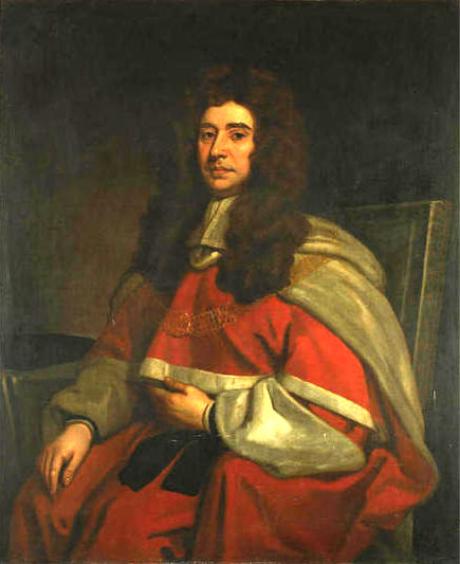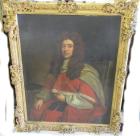Sir Edward Ward, (1638–1714), lawyer and judge, was born in Northamptonshire, the second son of William Ward of Preston, Rutland.
He was educated under Francis Meres at the free school at Uppingham, Leicestershire. Ward then studied at Clifford's Inn and in June 1664 entered the Inner Temple. He was called to the bar on 27 November 1670. On 30 March 1676 he married Elizabeth (1658–1723), daughter of Thomas Papillon MP, a London merchant. They had four sons and five daughters. Ward soon gained an extensive practice, particularly in the exchequer, where he was the leading pleader on the equity side of the court in 1680. In July 1683 Ward was counsel for Lord William Russell during his trial for treason. In November 1684 he was counsel for his father-in-law in the action for false imprisonment brought against him by Sir William Pritchard. Also in November 1684 Ward appeared for the earl of Macclesfield in the action of scandalum magnatum brought against John Starkey, a member of the Cheshire grand jury which had presented the peer as disaffected. From these cases it can be discerned that Ward's political sympathies lay with the whigs.
On 20 November 1687 Ward was called to the bench of the Inner Temple. Following the revolution of 1688 Ward was chosen by William III in April 1689 as a judge, but he was allowed to refuse the place probably because of the financial penalties involved in giving up his lucrative practice. In July 1689 Ward was assigned as counsel to Dr Elliott and others accused of dispersing James II's declaration. In April it was rumoured that Ward would be made a serjeant-at-law, but he did not receive a writ. In March 1693 he was sounded out about the possibility of becoming solicitor-general by the new lord keeper, Sir John Somers. In the event, on 30 March Ward kissed the king's hand for the post of attorney-general, his patent being dated 4 April 1693. William III had been influenced by some of his tory ministers to appoint Ward to the higher office, much to the chagrin of the solicitor-general, Sir Thomas Trevor, who was the junto whig candidate for the post. Ward was knighted on 30 October 1693. In November 1694 it was reported that Ward would be made lord chief baron of the exchequer, but that the appointment would be delayed to allow Ward to be made a serjeant-at-law. He was informed by the king of his impending appointment to the bench on 5 May 1695, and he was made a serjeant on the morning of 8 June, his patrons being lords Godolphin and Somers; in the afternoon he was sworn in as lord chief baron. It appears that the king offered him £500 p.a. as compensation for quitting his practice (but this remained unpaid until 1700, when it was raised to £600 p.a. and paid). After sitting as a judge on the home circuit, on 29 July 1695 Ward received a summons as an assistant to the House of Lords. This was a necessary step in view of the fact that he had a commission to sit as speaker of the Lords on the following day, when parliament was prorogued. He acted as speaker at two further prorogations before parliament was dissolved in October 1695. In March 1696 he tried Robert Charnock and his associates for treason. In January 1700 he excused himself from giving an opinion on the bankers' case. Following the dismissal of Somers from the lord chancellorship, in May 1700 Ward was named a commissioner of the great seal. In May 1701 he presided over the trials of Captain Kidd for murder and piracy. Ward was reappointed lord chief baron following the accession of Queen Anne in 1702. Ward was taken ill just before going on circuit in July 1714, and died on 16 July at his house in Essex Street on the Strand. He was buried at Stoke Doyle, Northamptonshire, which he had purchased in the mid-1690s. He was survived by his wife, four sons, including his heir, Edward, another lawyer, and five daughters, only one of whom had married when Ward's will was drawn up in 1712. As one newsletter writer put it, ‘the world will miss him, not only for his great ability in the law, but for his politeness in politics’ (Portland MSS, 5.472). This was certainly an improvement on the earl of Ailesbury's assessment when Ward was attorney-general that he and the recorder of London were ‘the two greatest blockheads of the robe’ (Bruce, 1.305). Ward also had the distinction of being the only law officer between 1680 and 1819 never to have sat in the House of Commons. Ward left five case notebooks (1673–97), nine volumes of exchequer cases (1696–1713), and twenty-one volumes of causes (1674–1714), all now in Lincoln's Inn library, London. His eldest son, Edward, rebuilt Stoke Doyle church and erected in it a monument to his father.
Samuel Pyeatt Menefee and Stuart Handley DNB
Kneller was born Gottfried Kniller in Lübeck, Germany. His father Zachary Kniller was a painter and the Chief Surveyor of the city of Lübeck. In about 1662 he read mathematics at Leyden University before turning to painting, studying under Ferdinand Bol and probably Rembrandt. He was in Rome and Venice from 1672 to 1675, probably painting portraits of the Venetian nobility, before settling in England in 1676. There he ran a successful studio producing replicas and copies. After being introduced to the Duke of Monmouth, he received sittings from the king and was launched as a court artist, establishing a reputation as a portrait painter in the grand manner.
In 1684-5 Kneller was in France, painting Louis XIV for Charles II. A court painter to James II and George I, he was appointed principal painter to William and Mary in 1688. He was knighted in 1692, and in 1695 received, in the presence of the king, an honorary Doctorate of Law from the University of Oxford. In 1700 he was created a Knight of the Holy Roman Empire by the Emperor Leopold I. He married Susanna Grave, a widow, in 1704; the couple were childless. In 1711 he became Governor of the first London Academy, and was re-elected annually until 1718. George I granted Kneller a baronetcy in 1715. At the time of his death in London, about five hundred works remained unfinished in his studio.


